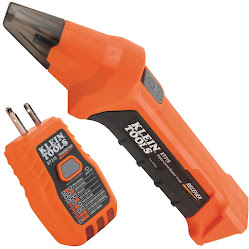How Much Can I Plug Into My Outlets?
Is It Safe For Circuit Breaker To Keep Tripping?
How To Determine Which Outlets Are On Which Breaker?
- Breaker box labels. If you're lucky, you or someone else has already done the work and labeled the breakers in your breaker box. Great! The labels may give you a general idea where to start. Note that a breaker labeled "Primary Bedroom" may indeed include outlets in the Primary Bedroom but there's a good chance that circuit includes outlets in other locations as well - for example a hallway or a bathroom. To match each home outlet to an individual breaker, the following methods can be used.
- Brute force breaker on/off. To match outlets to breakers, you can flip each breaker off one at a time. While off, check each outlet for power. Of course you can just just check what's plugged into an outlet and see if it has power. If nothing is plugged in, you can plug in a small lamp or other electrical device to check for power. Another option is to use a non-contact voltage tester (purchase on eBay). This tester will light-up and/or beep when its tip is placed at the outlet's surface. Be sure to follow the manufacturer's instructions for proper use.
- Circuit Breaker Finder (purchase on eBay). Another great option to match outlets to breakers is to use an electronic breaker finder. The finder works by first plugging in the provided transmitter into the outlet you want to match to a breaker. Next, at the breaker panel, you scan the surface of each breaker with the tool. The finder indicates the circuit with the outlet transmitter by lighting-up and/or beeping at the found breaker. You would then repeat this process for each outlet in your home.
Circuit Use Estimator
15 AMP Circuit 20 AMP Circuit
Add plug-in items for one breaker (items listed are examples only and will vary).
(1500W) Hair dryer:
(1200W) Vacuum cleaner:
(1000W) Microwave oven:
(800W) Toaster:
(600W) Refrigerator:
(400W) Blender:
(300W) Gaming PC:
(200W) Slow cooker:
(150W) 50" LED TV:
(100W) 100W Incandescent bulb:
(50W) Laptop charging:
(10W) 60W Equivalent LED bulb:
Notes: The Circuit Use Estimator is to be used for educational purposes only. The electrical appliances shown for each power rating are for example only. Your electrical appliances may use higher or lower power. Check with your appliance manufacture documentation for actual power requirements. The Circuit Use Estimator calculates the power for each circuit based on a typical 120V voltage value. For the 15A circuit, the maximum power is calculated to be 120V x 15A = 1800W. For the 20A circuit, the maximum power is calculated to be 120V x 20A = 2400W. The red line area on the gauge display covers the range of 80% to 100% of the maximum circuit value.
Home Fix DIY is an eBay affiliate partner. When you click links to various merchants on this site and make a purchase, this can result in this site earning a commission. Affiliate programs and affiliations include, but are not limited to, the eBay Partner Network.




